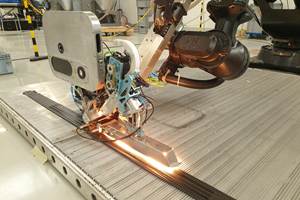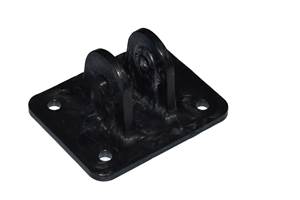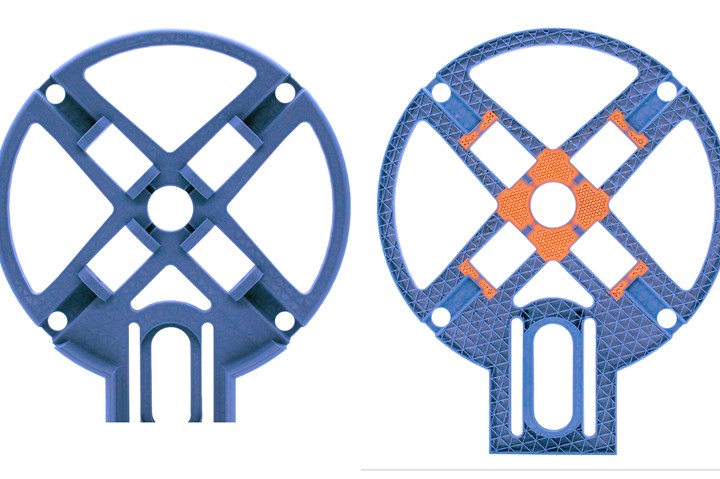
Teton Simulation’s SmartSlice design module for 3D printing resides within the slicer software and helps the user optimize the design and reduce print time. It also helps the user make decisions about where and how to deploy fiber reinforcement. On the left is a printed part and on the right is a cutaway of the same part that shows, in orange, where Teton recommended use of fiber reinforcement. Photo Credit: Teton Simulation
Any designer of composite parts and structures knows full well the challenges and opportunities posed by fiber-reinforced materials. The wide selection of resins, fibers, fiber formats and manufacturing processes allows a designer to custom-engineer a solution that puts fiber reinforcement exactly where it’s needed to meet a specific mechanical load. But designing for that fiber orientation is a complex and sometimes daunting task, fraught with potential for error that is best met by a well-trained, experienced designer working with complex CAD software.
These same design challenges exist when it comes to manufacturing with fiber-reinforced additive manufacturing (AM), although the landscape is, in some ways, more complex. “The question is where to put the fiber,” says Doug Kenik, CEO of Teton Simulation Software (Laramie, Wyo., U.S.), “and most users [of AM systems] don’t have the knowledge or skill to make that decision.” The AM equipment suppliers attempt to help users with that decision via design software — called slicer software — embedded in the system. Such software, Kenik notes, is typically proprietary and does not always make good decisions about fiber use. “There is a big gap between design for additive and the fiber placement process,” he argues.
As-designed vs. as-made
Jeff Wollschlager, VP - composite technology at CAD specialist Altair Engineering (Troy, Mich., U.S.), has long experience designing and simulating composite parts, and the company has a variety of tools on the market to meet designers’ needs. These include HyperWorks, OptiStruct, HyperMesh and ESAComp. Wollschlager says, “We have been ‘3D printing’ composites for quite some time when you look at all the automated layup methods of the past several decades. What has changed is the miniaturization of the technology. The ability to manufacture with these techniques including smaller and smaller details has been the largest advancement over the last half decade or so.”
One of the biggest challenges, he says, is embedded in the anisotropic nature of composite materials: “The challenge is in material modeling and progressing past our classical knowledge in homogeneous isotropic materials to become as confident with heterogeneous anisotropic materials as we have become with homogeneous isotropic. Not only do we have advanced 3D printing manufacturing techniques, the materials those machines are printing are advanced and require equal attention to detail.”
Paul Sohi, product marketing manager at CAD specialist Autodesk (San Rafael, Calif., U.S.), maker of TruComposites software, says the biggest challenge in designing for fiber-reinforced AM is bridging the as-designed and as-made gap. “Analyzing and simulating the additive deposition process for continuous carbon fiber is crucial to understanding how a part will be built,” he says. “Understanding how the real-world part compares to the original design will finally enable accurate FEA analysis to be run on this type of part.” Sohi also argues that there is an additional challenge: dealing with shear and layer lines when laying up any material in FFF [fused filament fabrication] format, which, he says, is how some fiber-reinforced AM systems function.
However, even an AM-specific design created in CAD software, whether it’s from Altair, Autodesk, Dassault Systèmes (Waltham, Mass., U.S.) or Siemens (Waltham), must be transferred into the AM machine environment and the slicing software employed there. This leads Wollschlager to his second challenge, which “is interoperability with manufacturing simulation vendors such that available product data in the manufacturing simulation can be used to efficiently develop highly accurate structural simulation models. The idea is that the ‘machine’ knows what it made, so we should use that information to automatically build models. In many cases, we are already doing this, but interoperability with each vendor can be challenging outside general acceptance and implementation of industry-proposed standards.”
For users of AM systems who don’t have access to traditional CAD solutions written specifically for composite materials and processes, the OEM slicer software embedded in the machine is the starting point for making a design and deciding where and how to deploy fiber reinforcement in an AM structure. And that slicing software may or may not drive good decision-making.
Kenik says Teton has developed software, called SmartSlice, that is embedded in an OEM’s slicer to help optimize part design, speed the build and guide more effective use of fiber reinforcement in an extrusion-based AM system. “The user can set up their stiffness and strength requirements — here’s how I’m pushing and pulling on the part,” Kenik says. “And then we can quickly validate it and say thumbs up, thumbs down this is going to work the way you want it to work. And then, further to that, we can optimize all the size parameters to get you the minimum build speed.”
In addition, SmartSlice assesses the geometry under loads and use cases to identify layers or regions of the part that require fiber reinforcement. “You don’t want to put fiber everywhere,” Kenik argues. “That’s expensive, and it takes a lot of time. If you can identify the layers and regions to apply fiber, that’s really impactful.”
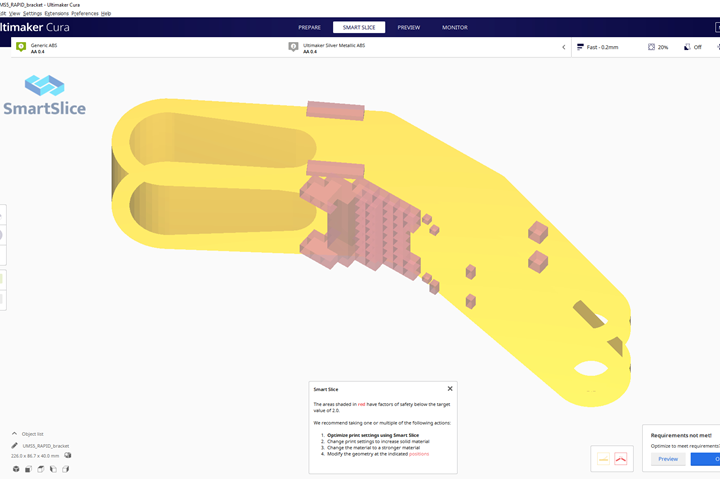
SmartSlice considers the physical requirements of the part and then calls out regions that need review to increase mechanical properties. One strategy that SmartSlice might recommend is to apply fiber-reinforced materials to the region. Photo Credit: Teton Simulation
SmartSlice is currently offered as a module for the Ultimaker Cura open source slicer platform, but Kenik says it can be made compatible with any slicer solution. Further, SmartSlice is configured to work with chopped fiber reinforcement only, although the company is working on a solution for continuous fiber reinforcement. “When you talk about continuous fiber composites in additive, you’re generally talking about a hybrid design where you have a mixture of plastic, chopped fiber-reinforced plastic and continuous fiber-reinforced plastic. So your flexibility goes way up, but so does your complexity. The matrix of possible design inputs goes way up, and that’s a challenge.” While such hybridization is not ubiquitous, it is common enough that design software must be prepared to accommodate it.
Kenik also argues that software solutions designed to address the use of continuous fiber reinforcement in AM leave too much room for error. “Basically, you take a design from CAD and put it in a slicer program and you’re just saying, ‘I think I need fiber here and here and here.’ But you have no way to virtually test that design, so you usually just overdesign the part, make sure you have a balanced and symmetric laminate and print it.”
Future things
Ultimately, the use of fiber reinforcement in AM may actually accelerate a trend already at work in the composites industry: democratization. The complexity and variability that make fiber-reinforced polymers so adaptable also make accessibility difficult for those who are not already well-versed in the principles of composite materials and manufacturing. Fiber-reinforced AM is, effectively, propelling composites manufacturing capabilities into the hands of people who have a strong “maker” streak, but only a rudimentary understanding of the materials. Already, within the AM community, there are now references to “composites machines,” which references use of fiber-reinforced materials in 3D printing. The idea that a composite can be so easily printed is enticing and intimidating. An adaptive and affordable AM software platform that offers strong integration of design, simulation and manufacturing process will help such users easily and intelligently deploy fiber reinforcement in 3D-printed structures. This has implications beyond AM.
“Now, you can buy a machine that allows you to print continuous fiber composites, so accessibility has gone way up,” says Kenik. Indeed, he envisions this ease of composites manufacturing adoption spilling over into traditional composites manufacturing processes: “Additive will accelerate and open up the market for continuous fiber composites.”
Altair’s Wollschlager, thinking about the future, says, “I think it is clear the direction we need to head: general industry consensus and implementation for data exchange formats, the addition of detailed heterogeneous anisotropic knowledge at undergraduate levels and a general openness to change the way we currently manufacture and design structure.”
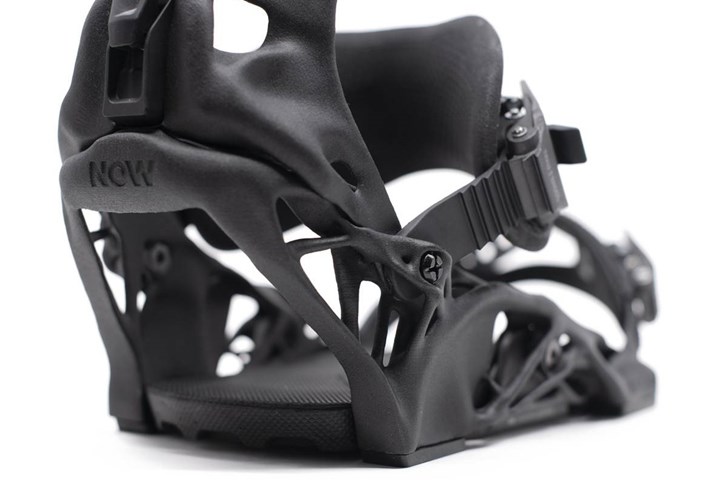
Although it does not use fiber-reinforced polymers, the NOW binding designed and developed by ADDIT•ION for snowboard manufacturer Nidecker Group is a good example of generative design. Generative design is a holistic discipline that fully integrates application, design and manufacturing process to create an optimally designed part. This snowboard binding was designed using Autodesk’s Fusion 360 CAD platform. Photo Credit: Autodesk
At Autodesk, Sohi says, “We’re particularly excited to see more simulation tools come to market that capture the anisotropic nature of additive manufacturing, and that’s not just in the arena of continuous carbon fiber. Across the industry, we’re taking important steps toward closing the gap between what’s designed in CAD and what is produced by machines on the factory floor. There is a chasm to cross between the perfect data we have in CAD and the realities of manufacturing.”
Kenik, for his part, foresees significant evolution in AM part design with fiber: “Though the hardware OEMs are coming at it from one direction, and the CAD providers are coming at it from another, at some point they will have to tie it together. The slicer will live in the CAD program and thus integrate everything in one package.”
This leads to the Holy Grail of AM in general, and AM with fiber in particular, which is the application of generative design principles. Generative design, says Sohi, holistically integrates design, engineering and manufacturing tasks into a unified discipline, enabling designers and engineers to gain new insights into parts manufacturing. Generative design, to date, has been primarily applied to isotropic materials, but its use with fiber-reinforced materials is coming.
“Process-aware generative design looks at the material, looks at the machines and, based on the geometry, guides your design and guides your machine configuration,” says Kenik. “That’s really powerful.”
Related Content
3D-printed CFRP tools for serial production of composite landing flaps
GKN Aerospace Munich and CEAD develop printed tooling with short and continuous fiber that reduces cost and increases sustainability for composites production.
Read MoreATLAM combines composite tape laying, large-scale thermoplastic 3D printing in one printhead
CEAD, GKN Aerospace Deutschland and TU Munich enable additive manufacturing of large composite tools and parts with low CTE and high mechanical properties.
Read MoreHybrid process marries continuous, discontinuous composites design
9T Labs and Purdue applied Additive Fusion Technology to engineer a performance- and cost-competitive aircraft bin pin bracket made from compression-molded continuous and discontinuous CFRTP.
Read MoreLarge-format 3D printing enables toolless, rapid production for AUVs
Dive Technologies started by 3D printing prototypes of its composite autonomous underwater vehicles, but AM became the solution for customizable, toolless production.
Read MoreRead Next
VIDEO: High-volume processing for fiberglass components
Cannon Ergos, a company specializing in high-ton presses and equipment for composites fabrication and plastics processing, displayed automotive and industrial components at CAMX 2024.
Read MoreAll-recycled, needle-punched nonwoven CFRP slashes carbon footprint of Formula 2 seat
Dallara and Tenowo collaborate to produce a race-ready Formula 2 seat using recycled carbon fiber, reducing CO2 emissions by 97.5% compared to virgin materials.
Read MoreDeveloping bonded composite repair for ships, offshore units
Bureau Veritas and industry partners issue guidelines and pave the way for certification via StrengthBond Offshore project.
Read More
















